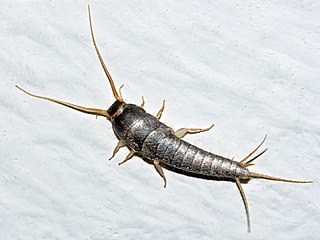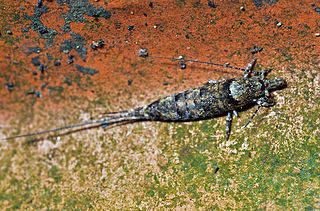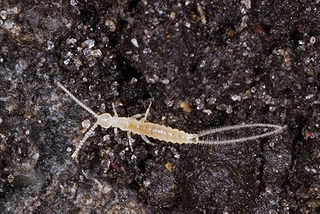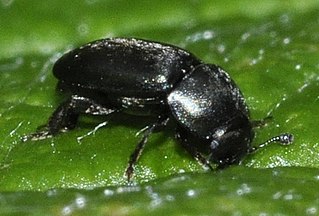
Diplacus aurantiacus, the sticky monkey-flower or orange bush monkey-flower, is a flowering plant that grows in a subshrub form, native to southwestern North America from southwestern Oregon south through most of California. It is a member of the lopseed family, Phrymaceae. It was formerly known as Mimulus aurantiacus.

Sassacus is a genus of jumping spiders that was first described by George and Elizabeth Peckham in 1895. It is likely named after Sassacus, a Native American chief of the 16th and 17th century.

The Machilidae are a family of insects belonging to the order Archaeognatha. There are around 250 described species worldwide. These insects are wingless, elongated and more or less cylindrical with a distinctive humped thorax and covered with tiny, close-fitting scales. The colour is usually grey or brown, sometimes intricately patterned. There are three "tails" at the rear of the abdomen: two cerci and a long central epiproct. They have large compound eyes, often meeting at a central point. They resemble the silverfish and the firebrat, which are from a different order, Zygentoma.

A silverfish is a small, wingless insect in the order Zygentoma. Its common name derives from the animal's silvery light grey colour, combined with the fish-like appearance of its movements. However, the scientific name indicates the silverfish's diet consists of carbohydrates such as sugar or starches.
Machilinus is a genus of rock bristletails in the family Meinertellidae. There are about 17 described species in Machilinus.

Machiloides is a genus of rock bristletails in the family Meinertellidae. There are at least two described species in Machiloides.
Mesomachilis is a genus of jumping bristletails in the family Machilidae. There are about six described species in Mesomachilis.
Pedetontus is a genus of jumping bristletails in the family Machilidae. There are about 10 described species in Pedetontus.
Petridiobius is a genus of jumping bristletails in the family Machilidae. There are at least two described species in Petridiobius.

Trigoniophthalmus is a genus of jumping bristletails in the family Machilidae. There are about 11 described species in Trigoniophthalmus.

Rhabdura is a suborder of two-pronged bristletails in the order Diplura. There are about 5 families and more than 290 described species in Rhabdura.

Meligethes is a genus of pollen beetles in the family Nitidulidae. There are more than 80 described species in Meligethes.

Texella is a genus of armoured harvestmen in the family Phalangodidae. There are more than 20 described species in Texella.
Pedetontus saltator, the jumping bristletail, is a species of jumping bristletail in the family Machilidae. It is found in North America.
Prokelisia is a genus of delphacid planthoppers in the family Delphacidae. There are about five described species in Prokelisia.
Narthecius grandiceps is a species of lined flat bark beetle in the family Laemophloeidae. It is found in North America.
Pedetontus submutans is a species of jumping bristletail in the family Machilidae. It is found in North America.
Petridiobius arcticus is a species of jumping bristletail in the family Machilidae. It is found in Europe & Northern Asia and North America.

Trigoniophthalmus alternatus is a species of jumping bristletail in the family Machilidae. It is found in Europe & Northern Asia and North America.
Dicellurata is a suborder of two-pronged bristletails in the order Diplura. There are at least 4 families and more than 170 described species in Dicellurata.










